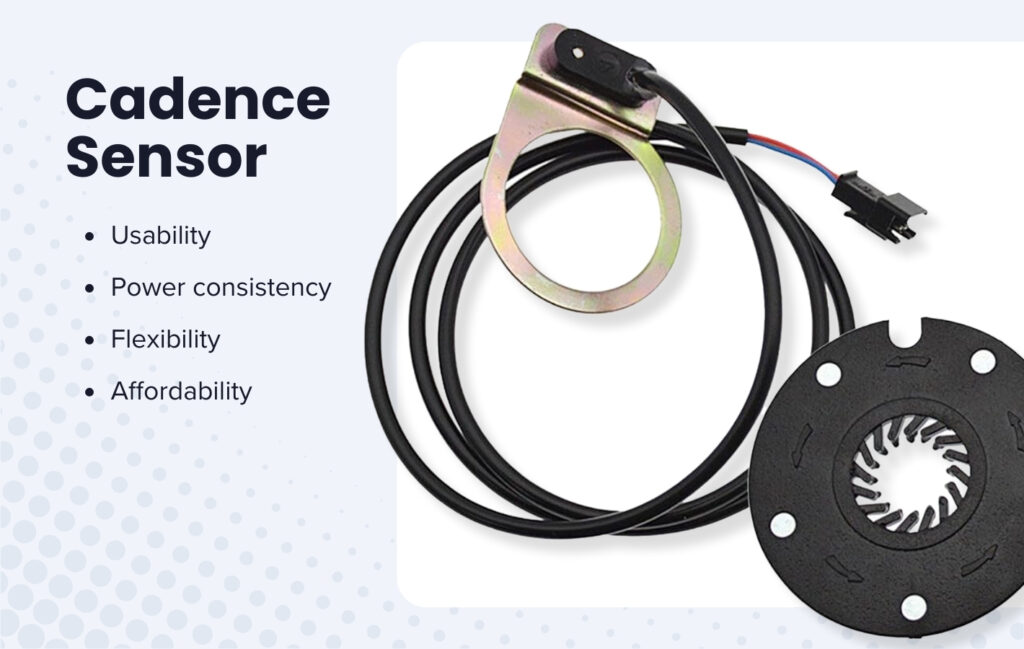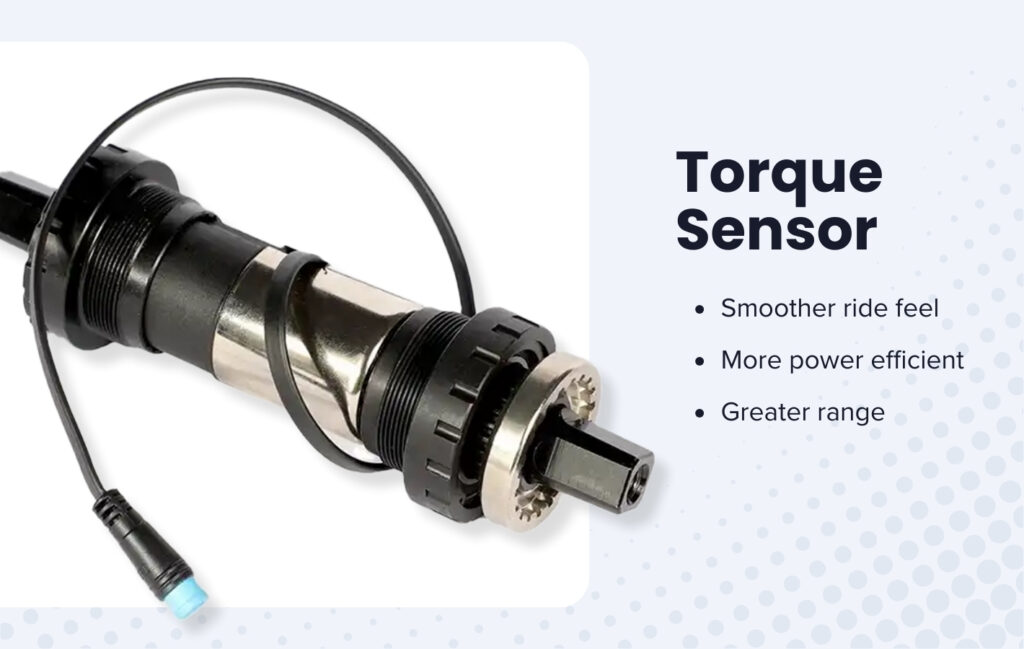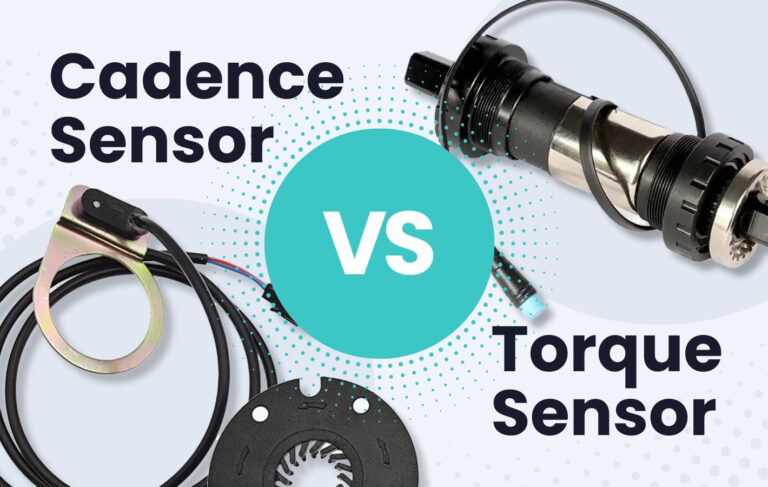An important decision when selecting your perfect electric bike is opting for a cadence sensor or torque sensor motor. Electric bike motors use a pedal assist system that gives you an extra burst of power when your feet hit the pedals.
However, cadence and torque sensors apply this power differently, so it’s critical to understand how they work before going ahead and spending your hard-earned cash on an e-bike.
Electric Bike Motor Technology Explained
E-bike motors transform electrical energy into mechanical energy. E-bikes use brushless direct current (BLDC) motors, which benefit from a high power-to-weight ratio that offers high speed, instant speed and torque control, low maintenance, and high efficiency.
A BLDC motor is formed of wires around a set of poles; the stator turns into an electromagnet when the motor’s controller takes current from the battery. It also features magnets that form the rotor, which interacts with the stator and activates a shaft to generate torque. That torque drives pedal assistance through a chainring connected to the shaft.
The Rise of Sensor-Driven Performance
E-bike motors are legally required to only kick into life when the rider pedals. While e-bike users can apply pedal assistance themselves, it’s more effective for them to sense the amount of effort being made automatically.
E-bikes increasingly use sensors to drive more effective performance. But deciding between cadence and torque sensors will depend on whether you want the bike to take on most of the work or put in the effort yourself.
Cadence Sensors – A Closer Look
Cadence sensors detect when you start pedaling and match the pedal assist mode you select. It provides a level of boost similar to a throttle, giving you an extra kick while you ride and stopping when you stop pedaling or when applying the brakes.

E-bike manufacturers usually have preset speeds for each pedal assist level. So, the effort you put in, and the level of pedal assist you select will set the power the motor provides. In other words, as your pedaling speed, or cadence, increases, the motor will contribute greater pedal assist until it reaches the required level.
For example, when you start a ride, the motor will produce a set amount of power to get you up to pace. But as the pedal cadence and forward momentum go higher, the motor contribution will decrease.
Cadence sensors use a magnet on the crank that turns the motor on when you begin pedaling and then turns it off when you stop.
Pros and Cons of Cadence Sensors
Cadence sensors are designed to assist riders’ pedaling, so the benefits include:
- Usability: Cadence sensors offer simple ease of use, requiring light pressure on the pedals to kick the motor into life. You can put in minimal or maximum effort, and the motor will engage at different levels. They are great for recreational riders or those with physical limitations.
- Power consistency: Cadence sensors offer a guarantee of power boost whenever you need it. You don’t need to add extra effort to gain additional power, which means you can climb a hill without putting too much work in or gain a little more speed while cruising along the seafront.
- Flexibility: The minimal effort cadence sensors require gives you flexibility in your rides. You can choose lower assist levels if you’re simply pottering around town or crank the pedal assist higher if you’re going on a more intense ride.
- Affordability: Cadence sensors e-bikes offer a relatively inexpensive option to add pedal assist to your riding experience.
That said, there may be some downsides to cadence sensor e-bikes depending on your e-bike needs, such as:
- Pedaling required: Cadence sensors can make riding easier, but they also require you to at least move the pedals a little before engaging the motor.
- Less physical effort: Some riders may feel they’re not working hard enough with a cadence sensor. You may think you receive too much pedal assistance compared to the effort you’re putting in.
- Lack of workout: Many riders want to feel in sync with their e-bike and feel their contribution delivers rewards. But cadence sensor bikes’ pedal assist can feel a bit counterintuitive and may not provide an intense enough workout.
- Potential range issues: If you’re keen for a long day of riding, your e-bike’s range is critical. That range can be affected by extensive use of high-level pedal assist, which will use up the e-bike’s battery and impact how far you can travel on a single charge.
Torque Sensors — A Deeper Dive
The alternative to cadence sensors is torque sensors, which measure how hard you’re riding and use that insight to determine how much power the motor should deliver. Torque sensors adjust how much power they provide in real-time, ensuring they increase or decrease motor output in line with how much force you provide through the pedals.

Torque sensors can either be placed at the frame’s dropout, where the rear wheel axle picks up the frame, or in the bottom bracket of your e-bike.
Pros and Cons of Torque Sensors
Torque sensors offer different benefits to their cadence compatriots, including:
- Intuitive riding: Torque sensor e-bikes can feel more intuitive as they adjust the level of assistance based on your effort. You won’t feel sudden jolts of power as pedal assist levels change as the sensor measures the assistance required and applies it dynamically.
- Greater range: Torque sensors typically offer quick engagement as the motor kicks into life when it senses greater pedal power. They typically use less battery and provide greater range levels. These systems don’t produce predetermined pedal assist levels and only deliver the required help, allowing you to conserve battery power and ride for longer distances.
Despite these positives, there can be some downsides to torque sensors. The main issue is that you get out what you put in with torque sensors. That means reaching higher speeds requires more upfront work, and maintaining that speed also demands more pedal power. So, torque sensors demand a greater workout but could pose too much of a challenge for riders with physical constraints.
Comparative Analysis: Cadence vs. Torque
Cadence sensors determine whether you’re pedaling, while torque sensors measure how hard you’re pedaling. If you’re looking for an e-bike that feels more natural and requires more contribution, torque sensors may be for you. Torque sensors allow you to manage your speed through pedaling and demand more leg work than cadence sensors. This immediately provides power output at set speeds.
As a result, torque sensors are complex and precise, measuring the level of effort to provide a more accurate input. Given the greater sophistication, torque sensors will typically be more expensive than cadence sensors, but prices are falling as the technology becomes more common.
Which Sensors Power Your Perfect Ride?
Choosing between cadence and torque sensors isn’t a matter of which is better, but rather which better suits your needs. Torque sensors require more effort to get the bike going and reach top speed, potentially offering a more strenuous workout and a more natural riding experience. While cadence sensors provide power that may feel effortless to some riders, the extra assistance and ease of use could encourage more people to get out on their e-bikes.
Ultimately, both forms of pedal assist will give you the extra power boost you need to reach new heights and explore new areas. The decision of cadence vs. torque sensors boils down to whether you want more pedal power or an e-bike offering greater assistance.



